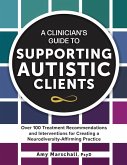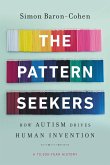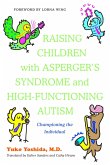Chris Dabbs, Audrey Scaer
Understanding and Affirming Autistic Clients
A Primer for Mental Health Professionals
Chris Dabbs, Audrey Scaer
Understanding and Affirming Autistic Clients
A Primer for Mental Health Professionals
- Broschiertes Buch
- Merkliste
- Auf die Merkliste
- Bewerten Bewerten
- Teilen
- Produkt teilen
- Produkterinnerung
- Produkterinnerung
An accessible primer on neuro-affirming clinical care for autistic clients, written from the perspective of autistic clinicians. It covers topics ranging from best language practices, assessment and diagnosis, communication with autistic clients, interventions, and ethical practices.
Andere Kunden interessierten sich auch für
![A Clinician's Guide to Supporting Autistic Clients A Clinician's Guide to Supporting Autistic Clients]() Amy MarschallA Clinician's Guide to Supporting Autistic Clients24,99 €
Amy MarschallA Clinician's Guide to Supporting Autistic Clients24,99 €![The Pattern Seekers The Pattern Seekers]() Simon Baron-CohenThe Pattern Seekers15,99 €
Simon Baron-CohenThe Pattern Seekers15,99 €![Turn Autism Around Turn Autism Around]() Mary Lynch BarberaTurn Autism Around14,99 €
Mary Lynch BarberaTurn Autism Around14,99 €![Emotionally Ever After Emotionally Ever After]() Brody KronstedtEmotionally Ever After12,99 €
Brody KronstedtEmotionally Ever After12,99 €![Shining As I Am Shining As I Am]() Makida ArshiShining As I Am15,99 €
Makida ArshiShining As I Am15,99 €![The Science of Evil The Science of Evil]() Simon Baron-CohenThe Science of Evil15,99 €
Simon Baron-CohenThe Science of Evil15,99 €![Raising Children with Asperger's Syndrome and High-Functioning Autism Raising Children with Asperger's Syndrome and High-Functioning Autism]() Yuko YoshidaRaising Children with Asperger's Syndrome and High-Functioning Autism18,99 €
Yuko YoshidaRaising Children with Asperger's Syndrome and High-Functioning Autism18,99 €-
-
-
An accessible primer on neuro-affirming clinical care for autistic clients, written from the perspective of autistic clinicians. It covers topics ranging from best language practices, assessment and diagnosis, communication with autistic clients, interventions, and ethical practices.
Produktdetails
- Produktdetails
- Verlag: Bloomsbury Academic
- Seitenzahl: 160
- Erscheinungstermin: 18. September 2025
- Englisch
- Abmessung: 227mm x 156mm x 9mm
- Gewicht: 263g
- ISBN-13: 9798881806804
- Artikelnr.: 73859804
- Herstellerkennzeichnung
- Libri GmbH
- Europaallee 1
- 36244 Bad Hersfeld
- gpsr@libri.de
- Verlag: Bloomsbury Academic
- Seitenzahl: 160
- Erscheinungstermin: 18. September 2025
- Englisch
- Abmessung: 227mm x 156mm x 9mm
- Gewicht: 263g
- ISBN-13: 9798881806804
- Artikelnr.: 73859804
- Herstellerkennzeichnung
- Libri GmbH
- Europaallee 1
- 36244 Bad Hersfeld
- gpsr@libri.de
Chris Dabbs & Audrey Scaer
Preface
Acknowledgments
Chapter 1: Understanding Autism and Autism Spectrum Disorder
Language Basics
Models of Understanding
The Spectrum of Autism
Common Myths and Misconceptions
Chapter 2: Recognizing and Assessing Autism
Late Identification of Autism
Self-Identification
Screening and Assessment Tools
The Role of Early Intervention
Cultural and Social Considerations
Chapter 3: Communication with Autistic Clients by Maggie Savage
Communicating with Speaking Autistic Clients
Communicating with Non-Speaking Autistics
Building Rapport and Trust with Autistic Clients
Chapter 4: Mental Health Concerns in Autistic Individuals
Co-occurrence of Autism with Other Mental Health Concerns
Attention-Deficit/Hyperactivity Disorder
Intellectual Developmental Disorders
Depression
Generalized Anxiety
Social Anxiety
Obsessive-Compulsive and Related Disorders
Trauma- and Stress-Related Disorders
Disordered Eating
Addiction
Borderline Personality Disorder
Conclusion
Chapter 5: Treatment Approaches and Interventions
Social Communication and Awareness Support
Exploring Camouflaging of Autistic Traits
Mindfulness and Relaxation
Emotions and Alexithymia
Safety Planning with Autistic Clients
Trauma Informed Care with Autistic Clients
Peer Support and Group Therapy
Collaborative and Interdisciplinary Care
Applied Behavioral Analysis
Chapter 6: Supporting Autistic Clients in Daily Life
Educational Support
Employment Support
Navigating the Healthcare and Support Service Systems
Chapter 7: Working with Families and Caregivers
Understanding the Family Perspective
Providing Education and Resources
Facilitating Family Support Groups
Encouraging Self-Care and Coping Strategies
Chapter 8: Ethical Considerations and Best Practices
Informed Consent and Confidentiality
Respect for Individual Differences and Preferences
Cultural Humility and Sensitivity
Continuing Education and Professional Development
The Importance of Ongoing Research and Collaboration
Glossary
Appendix A: Book Recommendations
Appendix B: Online Periodical Suggested Reading
Appendix C: Online Communities for Autistic Clients
Appendix D: Self-Diagnosis and Skill Resources for Clients
Appendix E: Free Training and Professional Development in Autism
References
Index
About the Authors
Acknowledgments
Chapter 1: Understanding Autism and Autism Spectrum Disorder
Language Basics
Models of Understanding
The Spectrum of Autism
Common Myths and Misconceptions
Chapter 2: Recognizing and Assessing Autism
Late Identification of Autism
Self-Identification
Screening and Assessment Tools
The Role of Early Intervention
Cultural and Social Considerations
Chapter 3: Communication with Autistic Clients by Maggie Savage
Communicating with Speaking Autistic Clients
Communicating with Non-Speaking Autistics
Building Rapport and Trust with Autistic Clients
Chapter 4: Mental Health Concerns in Autistic Individuals
Co-occurrence of Autism with Other Mental Health Concerns
Attention-Deficit/Hyperactivity Disorder
Intellectual Developmental Disorders
Depression
Generalized Anxiety
Social Anxiety
Obsessive-Compulsive and Related Disorders
Trauma- and Stress-Related Disorders
Disordered Eating
Addiction
Borderline Personality Disorder
Conclusion
Chapter 5: Treatment Approaches and Interventions
Social Communication and Awareness Support
Exploring Camouflaging of Autistic Traits
Mindfulness and Relaxation
Emotions and Alexithymia
Safety Planning with Autistic Clients
Trauma Informed Care with Autistic Clients
Peer Support and Group Therapy
Collaborative and Interdisciplinary Care
Applied Behavioral Analysis
Chapter 6: Supporting Autistic Clients in Daily Life
Educational Support
Employment Support
Navigating the Healthcare and Support Service Systems
Chapter 7: Working with Families and Caregivers
Understanding the Family Perspective
Providing Education and Resources
Facilitating Family Support Groups
Encouraging Self-Care and Coping Strategies
Chapter 8: Ethical Considerations and Best Practices
Informed Consent and Confidentiality
Respect for Individual Differences and Preferences
Cultural Humility and Sensitivity
Continuing Education and Professional Development
The Importance of Ongoing Research and Collaboration
Glossary
Appendix A: Book Recommendations
Appendix B: Online Periodical Suggested Reading
Appendix C: Online Communities for Autistic Clients
Appendix D: Self-Diagnosis and Skill Resources for Clients
Appendix E: Free Training and Professional Development in Autism
References
Index
About the Authors
Preface
Acknowledgments
Chapter 1: Understanding Autism and Autism Spectrum Disorder
Language Basics
Models of Understanding
The Spectrum of Autism
Common Myths and Misconceptions
Chapter 2: Recognizing and Assessing Autism
Late Identification of Autism
Self-Identification
Screening and Assessment Tools
The Role of Early Intervention
Cultural and Social Considerations
Chapter 3: Communication with Autistic Clients by Maggie Savage
Communicating with Speaking Autistic Clients
Communicating with Non-Speaking Autistics
Building Rapport and Trust with Autistic Clients
Chapter 4: Mental Health Concerns in Autistic Individuals
Co-occurrence of Autism with Other Mental Health Concerns
Attention-Deficit/Hyperactivity Disorder
Intellectual Developmental Disorders
Depression
Generalized Anxiety
Social Anxiety
Obsessive-Compulsive and Related Disorders
Trauma- and Stress-Related Disorders
Disordered Eating
Addiction
Borderline Personality Disorder
Conclusion
Chapter 5: Treatment Approaches and Interventions
Social Communication and Awareness Support
Exploring Camouflaging of Autistic Traits
Mindfulness and Relaxation
Emotions and Alexithymia
Safety Planning with Autistic Clients
Trauma Informed Care with Autistic Clients
Peer Support and Group Therapy
Collaborative and Interdisciplinary Care
Applied Behavioral Analysis
Chapter 6: Supporting Autistic Clients in Daily Life
Educational Support
Employment Support
Navigating the Healthcare and Support Service Systems
Chapter 7: Working with Families and Caregivers
Understanding the Family Perspective
Providing Education and Resources
Facilitating Family Support Groups
Encouraging Self-Care and Coping Strategies
Chapter 8: Ethical Considerations and Best Practices
Informed Consent and Confidentiality
Respect for Individual Differences and Preferences
Cultural Humility and Sensitivity
Continuing Education and Professional Development
The Importance of Ongoing Research and Collaboration
Glossary
Appendix A: Book Recommendations
Appendix B: Online Periodical Suggested Reading
Appendix C: Online Communities for Autistic Clients
Appendix D: Self-Diagnosis and Skill Resources for Clients
Appendix E: Free Training and Professional Development in Autism
References
Index
About the Authors
Acknowledgments
Chapter 1: Understanding Autism and Autism Spectrum Disorder
Language Basics
Models of Understanding
The Spectrum of Autism
Common Myths and Misconceptions
Chapter 2: Recognizing and Assessing Autism
Late Identification of Autism
Self-Identification
Screening and Assessment Tools
The Role of Early Intervention
Cultural and Social Considerations
Chapter 3: Communication with Autistic Clients by Maggie Savage
Communicating with Speaking Autistic Clients
Communicating with Non-Speaking Autistics
Building Rapport and Trust with Autistic Clients
Chapter 4: Mental Health Concerns in Autistic Individuals
Co-occurrence of Autism with Other Mental Health Concerns
Attention-Deficit/Hyperactivity Disorder
Intellectual Developmental Disorders
Depression
Generalized Anxiety
Social Anxiety
Obsessive-Compulsive and Related Disorders
Trauma- and Stress-Related Disorders
Disordered Eating
Addiction
Borderline Personality Disorder
Conclusion
Chapter 5: Treatment Approaches and Interventions
Social Communication and Awareness Support
Exploring Camouflaging of Autistic Traits
Mindfulness and Relaxation
Emotions and Alexithymia
Safety Planning with Autistic Clients
Trauma Informed Care with Autistic Clients
Peer Support and Group Therapy
Collaborative and Interdisciplinary Care
Applied Behavioral Analysis
Chapter 6: Supporting Autistic Clients in Daily Life
Educational Support
Employment Support
Navigating the Healthcare and Support Service Systems
Chapter 7: Working with Families and Caregivers
Understanding the Family Perspective
Providing Education and Resources
Facilitating Family Support Groups
Encouraging Self-Care and Coping Strategies
Chapter 8: Ethical Considerations and Best Practices
Informed Consent and Confidentiality
Respect for Individual Differences and Preferences
Cultural Humility and Sensitivity
Continuing Education and Professional Development
The Importance of Ongoing Research and Collaboration
Glossary
Appendix A: Book Recommendations
Appendix B: Online Periodical Suggested Reading
Appendix C: Online Communities for Autistic Clients
Appendix D: Self-Diagnosis and Skill Resources for Clients
Appendix E: Free Training and Professional Development in Autism
References
Index
About the Authors








